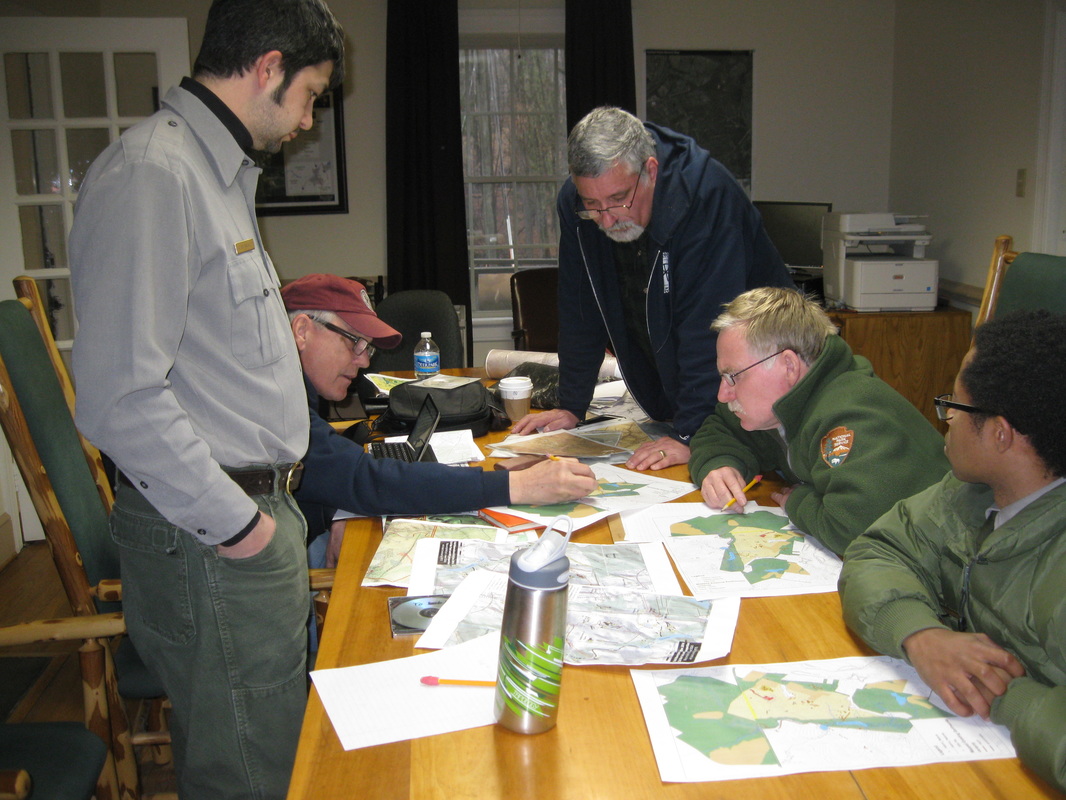
The Petersburg Project embraces a cross-disciplinary approach involving textual research, field surveys, archeological investigations, and detailed analyses of the contemporary maps and photographs. We are making use of some of the newest tools available, including LiDAR, high-resolution digital scans of old photographs, and geographical information systems (GIS); as well as some of the oldest, such as eyeballs and boot leather on the ground. Our methods are most similar to those of battlefield archaeology but we like to think we are "lurching ahead" in new directions. Sometimes, we may fall over. Oops. Our bad.
Our personal work will be freely available to all (with due credit). We believe a website is the best vehicle to share information, piece at a time. Here we explain our methods, lay out our evidence, and present our findings as well as random thoughts, ruminations, and hallucinations. We intend the site to be a living document that will grow and evolve for years as we add material and make corrections.
Our desire is to advance knowledge and assist the activities, not just of historians who write, but also public historians, landowners, organizations, and government agencies who preserve and interpret the earthworks in their care. We believe that interest in the subject of military engineering and fortifications in particular is growing.
We don't want to do this alone. We like trudging around the woods with like-minded folks, looking at historic piles of dirt, trying to get into the heads of the military engineers and the common soldiers of 1864-1865.
ABOUT US

Dr. Philip Shiman is a professional historian whose primary interest has been military engineering of all periods, but especially focusing on the evolution of field fortifications during the American Civil War. During the 1980s Dr. Shiman invested six summers as a seasonal interpreter at Petersburg National Battlefield, where he designed and oversaw the construction of a full-scale replica of the Union siege line that the park still maintains as a permanent exhibit at Tour Stop Six. (The park's display is informally referred to as "Fort Shiman.") In 1992 he cofounded the Civil War Fortification Study Group, a nonprofit organization dedicated to promoting the interpretation and preservation of Civil War earthworks. During his career he has lectured in public and professional military forums and participated in numerous engineering-related living history demonstrations. He has been described as the "Master of the Gabion." Although in his other life he studied the history of modern military technology for the US Department of Defense. Dr. Shiman holds degrees in history -- a B.A. from Yale and a Ph.D. from Duke University. He lives in Springfield, Virginia.

David Lowe has been a National Park Service historian for the last 28 years and spent much of his career applying the technologies of geospatial analysis (GIS) and geographic positioning systems (GPS) to the study of historic battlefields. His work for the Civil War Sites Advisory Commission in the early 1990s led to methodologies used to survey battlefields today. The concepts he developed of "defining features," "study area," and "core area" have been used to determine the extent and condition of hundreds of battlefields from the War of 1812, the Revolution, and the American Civil War. In his work for the park service, he has supervised mapping of more than 130 miles of surviving fortifications. As co-founder of the Civil War Fortification Study Group, he has tramped over and documented many more miles of earthworks. Lowe has a BA in Anthropology from the Ohio State University and holds a masters degree in American history from George Mason University. He is editor of Meade's Army: the Private Notebooks of Lt. Col. Theodore Lyman (Kent State University Press, 2007). Lowe is currently retired and resides in Washington, D.C.

Julia Steele grew up near Washington Crossing, PA, and developed an early interest in the Revolutionary War which expanded to the Civil War after family trips to Gettysburg. At the start of her professional career she recorded and assessed WWII and Cold War sites in Alaska. She joined the National Park Service Northeast Region Archeology Program in 1994 and has worked on Civil War era projects at Petersburg, Gettysburg, Fredericksburg, Spotsylvania and Cold Harbor. She was part of a five year research project at Valley Forge, which led to reinterpretation of significant aspects of the encampment. Since 2006, she has been Cultural Resource Manager at Petersburg National Battlefield, served as archaeologist for other Virginia parks and is now Chief of Resource Management at Petersburg. Steele has a B.A. in Anthropology from the University of Pennsylvania and a masters in Anthropology from Binghamton University. She has contributed publications, grey literature and presentations on military archaeology and other archaeology topics. She lives in Colonial Heights, Virginia. Julie retired in 2021 but remains active with the Petersburg Battlefield Foundation, the Petersburg Civil War Roundtable, and consults on archeology and history with the park.
Petersburg. IT'S A SIEGE !! And we're proud of it.
 It's a siege! Official circular initiating siege operations. OR XL Part I.
It's a siege! Official circular initiating siege operations. OR XL Part I.
Comparing maps and notes about the fighting around Pegram's Farm, October 1864. L to R: Adam Baghetti, David Lowe, Phil Shiman, Dave Shockley, Emmanuel Dabney.


